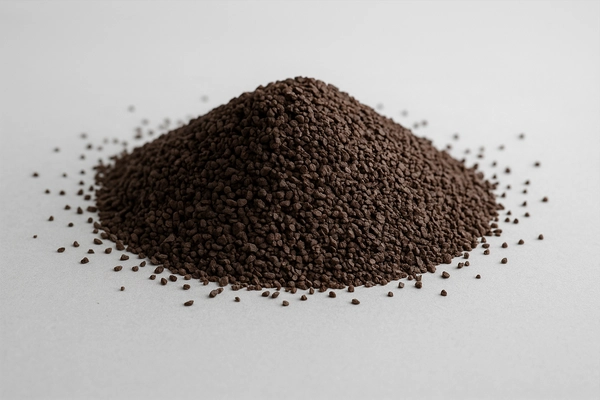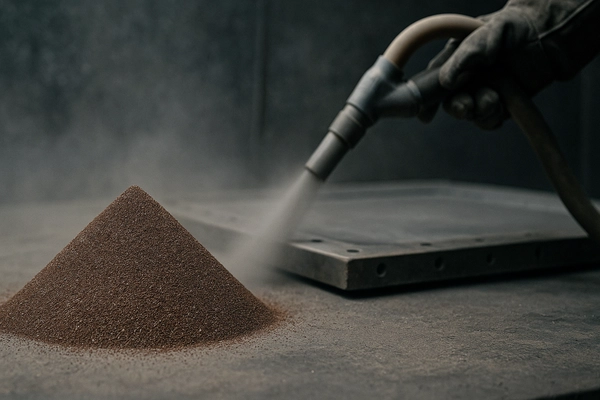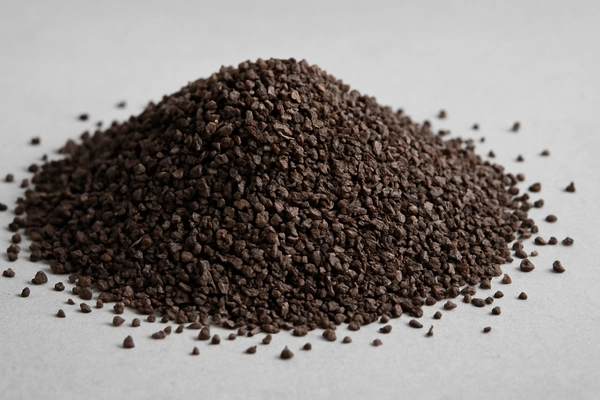Key Properties of Brown Fused Alumina
Brown fused alumina (BFA) is one of the most widely used synthetic corundum abrasives, known for its outstanding mechanical, thermal, and chemical stability. Below are its key characteristics:
- High Hardness: With a Mohs hardness of 9.0, BFA is extremely wear-resistant and suitable for aggressive grinding and cutting operations. It is second only to diamond in hardness among common industrial materials.
- High Density and Strength: The bulk density of BFA typically ranges between 3.98–4.08 g/cm³, and it offers tensile strength of up to 400–500 MPa, making it ideal for applications under mechanical stress.
- Thermal Resistance: BFA maintains structural stability at high temperatures, with a melting point of approximately 2040°C. It performs reliably in high-temperature environments such as ironmaking, metallurgy, and refractory processing.
- Chemical Stability: Brown fused alumina shows strong resistance to acids, alkalis, and other corrosive chemicals at room temperature. This makes it a long-lasting material in harsh chemical and environmental conditions.
- Color Characteristics: The material typically appears in brown or reddish-brown shades, though variations such as yellow, orange, pink, or purple may occur depending on trace elements. These do not affect its industrial performance.
With its combination of hardness, thermal durability, and chemical stability, brown fused alumina serves as a highly reliable material for abrasives, blasting media, and refractory applications in demanding industrial environments.
Manufacturing Process of Brown Fused Alumina
Brown fused alumina (BFA) is primarily produced by melting calcined bauxite in an electric arc furnace at temperatures exceeding 2000°C. However, alternative methods have also been developed in response to material availability, energy efficiency, and environmental considerations. Below are three common manufacturing processes:
1. Bauxite Smelting Method
This is the most widely used industrial method. Calcined bauxite—rich in Al₂O₃—is fused with fluxing agents in an electric arc furnace. After melting and cooling, the fused mass is crushed, purified, and graded to produce high-quality BFA. This process supports large-scale production and offers consistent product quality, though it requires high energy input and generates industrial emissions.
2. Carbothermic Reduction Method
In this process, alumina powder is mixed with carbonaceous materials such as coke and heated at high temperatures to reduce aluminum oxide. The resulting fused product is then refined into BFA. This method features lower production cost and simpler operation but produces large amounts of CO₂ emissions due to carbon usage.
3. Hydrogen Reduction via Natural Gas
This advanced technique involves producing hydrogen from natural gas through syngas generation and water-gas shift reactions. The hydrogen then reacts with alumina to produce aluminum, which is later processed into BFA. Although this method benefits from cleaner raw materials and lower material costs, it still requires significant energy and water resources, and involves complex processing steps.
Conclusion
Each BFA manufacturing method has its own advantages and limitations in terms of cost, energy consumption, scalability, and environmental impact. Selection of the production process should consider local resources, environmental regulations, and end-use performance requirements. Continuous innovation is driving the development of cleaner and more efficient manufacturing technologies in the abrasives industry.
Product Types of Brown Fused Alumina
Brown fused alumina is available in various forms to meet the needs of different industrial applications. Below are the major product categories:

BFA Fine Grit (F60–F120)
Ideal for sandblasting, surface preparation, and precision grinding of stainless steel and aluminum. Offers balance between cutting power and surface finish.
View Details
BFA Micro Powder (F150–F240)
Used in polishing, lapping, and fine abrasives for electronics and ceramics. Offers tight particle size distribution and excellent purity.
View Details
BFA for Sandblasting
Optimized for aggressive cleaning and etching of metal surfaces. Commonly used in shipyards, fabrication shops, and industrial maintenance.
View Details
Calcining Brown Fused Alumina
Calcining Brown Fused Alumina offers high hardness, low impurities, and thermal stability—ideal for grinding wheels, refractories, and abrasives.
View DetailsIndustries Using Brown Fused Alumina
Thanks to its high hardness, thermal resistance, and chemical stability, brown fused alumina is widely adopted across multiple industrial sectors. Its ability to withstand high mechanical stress and aggressive environments makes it a versatile material for demanding applications. Below are the key industries utilizing BFA:
1. Abrasive Tool Manufacturing
BFA is a core raw material for producing bonded and coated abrasives, including grinding wheels, cutting discs, sandpaper, and flap wheels. Its consistent grit structure and toughness enable precise cutting and prolonged tool life, especially in metalworking and surface finishing operations.
2. Refractory Industry
Brown fused alumina is commonly used in refractory castables, bricks, gunning mixes, and ramming masses. Its ability to endure high temperatures and maintain structural integrity under thermal cycling makes it ideal for furnaces, kilns, and metallurgical vessels.
3. Surface Preparation and Sandblasting
BFA’s angular particle shape and high hardness make it an effective blasting media for surface cleaning, paint removal, rust elimination, and etching. It is especially useful for cleaning stainless steel, cast iron, and non-ferrous metals without contaminating the substrate.
4. Foundry and Metallurgy
In the foundry and metallurgical sectors, BFA is used as an anti-slip material, filler for filters, and as a thermally stable aggregate. It enhances efficiency in molten metal handling and helps maintain cleanliness in filtration systems.
5. Ceramic and Precision Components
Fine and micro-sized BFA powders are used in technical ceramics, spark plugs, and electronic substrates due to their insulating properties and abrasion resistance. These applications demand material uniformity and chemical inertness, both of which BFA can deliver.
Conclusion
From heavy-duty grinding wheels to precision ceramic components, brown fused alumina supports a broad range of industrial applications. Its adaptability across different sectors makes it a staple material for manufacturers and engineering teams seeking reliable performance under extreme conditions.
Grit Sizes and Chemical Composition of Brown Fused Alumina
Brown fused alumina is available in a wide range of FEPA-standard grain sizes to suit various industrial applications. Each size category corresponds to specific performance and chemical purity standards. Below are the typical specifications for abrasive and refractory use.
For Abrasive Applications
| Grain Size | Al2O3 | TiO2 | CaO | SiO2 | Fe2O3 | Magnetic (%) |
|---|---|---|---|---|---|---|
| F4–F80 | 95.0–95.9 | 1.7–3.4 | 0.42 max | 1.0 max | 0.3 max | 0.05 max |
| F90–F150 | 94.5–95.9 | 1.7–3.6 | 0.42 max | 1.0 max | 0.3 max | 0.03 max |
| F180–F220 | 94.0–95.9 | 1.7–3.8 | 0.45 max | 1.2 max | 0.3 max | 0.02 max |
| F230–F800 | 93.5 min | 1.7–3.8 | 0.45 max | 1.2 max | 0.3 max | – |
| F1000–F1200 | 93.0 min | ≤4.0 | 0.50 max | 1.4 max | 0.3 max | – |
| P1200–P2500 | 92.5 min | ≤4.2 | 0.55 max | 1.6 max | 0.3 max | – |
For Refractory Applications
| Grain Size | Al2O3 | TiO2 | CaO | SiO2 | Fe2O3 | Magnetic (%) |
|---|---|---|---|---|---|---|
| 0–1mm / 1–3mm / 3–5mm / 5–8mm / 8–12mm | 95.0 min | 0.25 max | 1.0 max | 3.0 max | – | 0.05 max |
| 0–3mm / 0–5mm / 0–10mm / 0–25mm | 95.0 min | 0.25 max | 1.0 max | 3.0 max | – | 0.05 max |
| 180#–0 / 240#–0 / 320#–0 | 94.0 min | 0.30 max | 1.5 max | 3.5 max | – | 0.03 max |
Both abrasive and refractory applications demand precise control over grain size and chemical composition to ensure consistent performance. Whether you require coarse macro grains for structural stability or micro powders for precision grinding, brown fused alumina can be customized to meet your specific technical requirements.